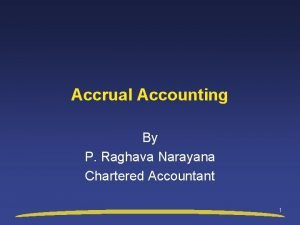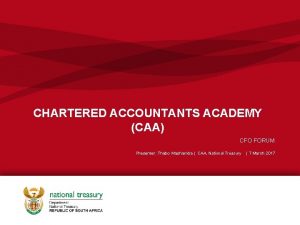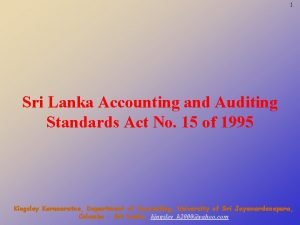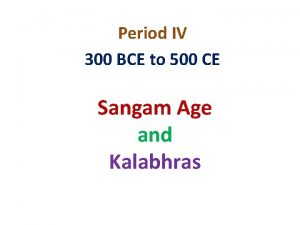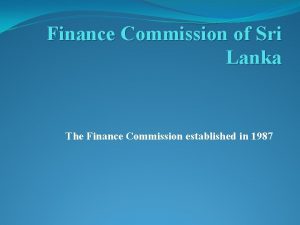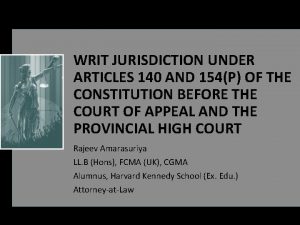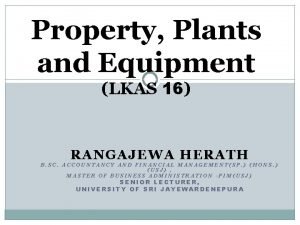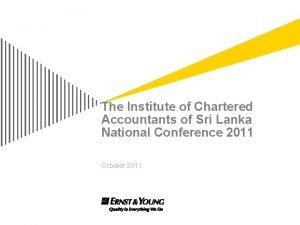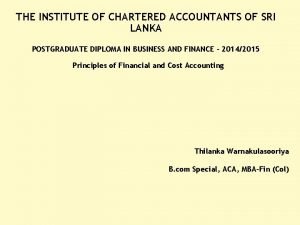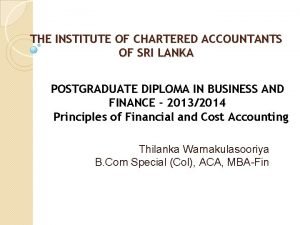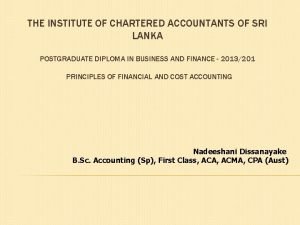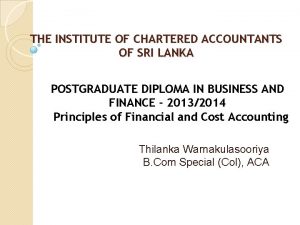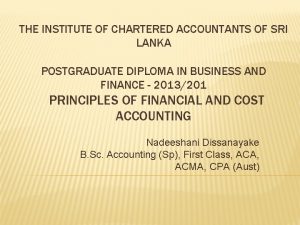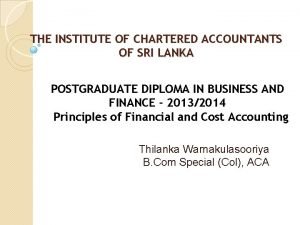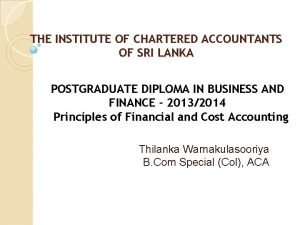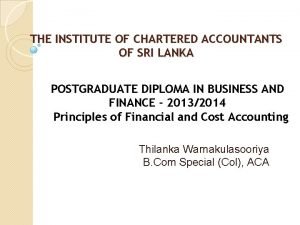THE INSTITUTE OF CHARTERED ACCOUNTANTS OF SRI LANKA





















- Slides: 21

THE INSTITUTE OF CHARTERED ACCOUNTANTS OF SRI LANKA POSTGRADUATE DIPLOMA IN BUSINESS AND FINANCE - 2013/2014 Principles of Financial and Cost Accounting Thilanka Warnakulasooriya B. Com Special (Col), ACA

LKAS 26 - Retirement benefit plans ‘Retirement benefit plans’ are ‘arrangements whereby an entity provides benefits for its employees on or after termination of service (either in the form of an annual income or as a lump sum), when such benefits, or the employer’s contributions towards them, can be determined or estimated in advance of retirement from the provisions of a document or from the entity’s practices’. POSTGRADUATE DIPLOMA IN BUSINESS AND FINANCE 2

Retirement benefit plan �Defined contribution plans. ◦ Retirement benefit plans whereby retirement benefits to be paid to plan participants are determined by contributions to a fund together with investment earnings thereon.

� Company’s only obligation is to pay agreed amount into plan � Recognition and measurement Expense in the period Liability recognized for contributions unpaid at period end. � Disclosure Disclose amount recognized as expense

�Defined benefit plans. ◦ Retirement benefit plans whereby retirement benefits to be paid to plan participants are determined by reference to a formula usually based on employees’ earnings and/or years of service

Defined benefit plans - report � The report of a defined benefit plan should contain either: A statement that shows the net assets available for benefits; the actuarial � present value of promised retirement benefits (distinguishing between vested benefits and non-vested benefits) and the resulting excess or deficit � � A statement of net assets available for benefits, including either a note � disclosing the actuarial retirement benefits � (distinguishing between vested benefits and non-vested benefits) or a reference to this information in an accompanying actuarial report present value of promised

ex: Extract from Annual Report � j) Employee benefits � (i) Defined contribution plans � � A defined contribution plan is a post-employment benefit plan under which contributions are made into a separate fund and the entity will have no legal or constructive obligation to pay further amounts. Obligations for contributions to defined contribution plan are recognised as an employee benefit expense in profit or loss in the periods during services is rendered by employees. Prepaid contributions are recognised as an asset to the extent that a cash refund or a reduction in future payments is available. � � Employee Provident Fund � All employees of the Company are members of the Sri Lanka Telecom Provident Fund to which the Company contributes 15% of such employees’ basic salary and allowances. � All employees of subsidiaries of the Group except for Sri Lanka Telecom (Hong Kong) Limited and SLT Services (Private) Ltd are members of Employees’ Provident Fund (EPF), to which respective subsidiaries contribute 12% of such employees’ basic salary and allowances. Employees of SLT Services (Private) Ltd are members of Employees’ � Provident Fund (EPF), where the Company contribute 15% of such employees’ basic salary and allowances. � � Employee Trust Fund � The Company and other subsidiaries contribute 3% of the salary of each employee to the Employees’ Trust Fund.

� ii) Defined benefit plans � A defined benefit plan is a post-employment benefit plan other than a defined contribution plan. The Group’s net obligation in respect of defined benefit plans is calculated separately for each plan by estimating the amount of future benefit that employees have earned in return for their service in the current and prior periods; that benefit is discounted to determine its present value. The valuation is performed annually by a qualified actuary using the projected unit credit method. When the valuation results in a benefit to the Group, the recognised asset is limited to the total of any unrecognised past service costs and the present value of economic benefits available in the form of any future refunds from the plan or reductions in future contributions to the plan. An economic benefit is available to the Group if it is realisable during the life of the plan, or on settlement of the plan liabilities. When the benefits of a plan are improved, the portion of the increased benefit relating to past service by employees is recognised in profit or loss on a straight-line basis over the average period until the benefits become vested. To the extent that the benefits vest immediately, the expense is recognised immediately inprofit or loss. The Group recognises all actuarial gains and losses arising from defined benefit plans directly in the other comprehensive income and all expenses related todefined benefit plan in personnel expense in profit or loss.

SLFRS 2 – Share-based Payments � Share plans & share option plans are becoming an increasingly common form of employee remuneration � Some entities also issue shares or share options to pay suppliers

Equity-settled share-based payments �An entity issues or transfers its own equity instruments as consideration for goods or services. Includes ◦ Share ownership schemes ◦ Employee options

Cash-settled share-based payments ◦ An entity pays cash calculated by reference to the price of its own equity instruments as consideration for goods or service ◦ Includes share appreciation rights

LKAS 21 The Effects of Changes in Foreign Exchange Rates �Definitions � Functional currency is the currency of the primary economic environment in which the entity operates. � Presentation currency is the currency in which the financial statements are presented. � Foreign currency is a currency other than the functional currency of an entity. � Closing � Spot rate is the spot exchange rate at the reporting date. exchange rate is the exchange rate for immediate delivery.

� Foreign operation is a subsidiary, associate, joint venture or branch of the reporting enterprise, the activities of which are based or conducted in a country other than the country of the reporting entity. � Net investment in a foreign operation is the amount of the reporting entity’s interest in the net assets of that operation. � Monetary items are currency held and assets and liabilities to be received or paid in fixed or determinable number of units of currency.

Determining functional currency The currency: �That mainly influences sales price �of country whose rules & regulations influence sales price �that influences labour, materials and other costs �in which financing generated �in which receipts from activities retained

� Initial recognition ◦ record foreign currency transactions in a consistent manner. ◦ Every transaction will be translated into the functional currency at the spot rate ruling at the time of the transaction. � Reporting at the ends of subsequent reporting periods Monetary items Non monetary items measured at cost Non monetary items measured at FV • Closing rate – Rate prevailed at end of the reporting period. • Exchange rate at the date of the transaction • Exchange rate at the date when the FV was determined.

Recognition of exchange differences �Exchange differences arising on settlement, or translating at the reporting date, of monetary items all go to profit or loss. �If gains/losses on a non-monetary item are taken to other comprehensive income (OCI) then any exchange difference is also taken to equity, through other comprehensive income. �If gains/losses on a non-monetary item are NOT taken to equity then any exchange difference is taken to profit or loss.

Presentation currency If the presentation currency is different to the functional currency: ◦ Assets/liabilities are translated at closing rate ◦ Income/expenses are translated at actual rate (average may be used) ◦ Exchange differences are taken to equity, through other comprehensive income ◦ Cumulative exchange difference reclassified to profit or loss on disposal of subsidiary.

LKAS 36 -Impairment of Assets � The purpose of the Standard is to ensure that assets are carried at no more than their recoverable amount. � If an asset’s carrying value exceeds the amount that could be received through use or through selling the asset, then the asset is impaired and IAS 36 requires an entity to make provision for the impairment loss

Identifying an Impairment loss � An entity has to assess at the end of each reporting period whethere is any indication that an asset is impaired. � Further, even if there is no indication of any impairment, these assets should be tested for impairment. ◦ An intangible asset that has an indefinite useful life • ◦ An intangible asset that is not yet available for use • ◦ Goodwill that has been acquired in a business combination

Indicate that an asset is impaired. � External sources � Internal sources of information

Ex: Impairment Considerations � Machinery was originally acquired for LKR 80, 000. It was expected to have a useful life of ten years and no residual value. At the start of year six, there was a downturn in demand due to a competitor product entering the market, and this has led to an impairment of the asset. The impairment has been calculated as being LKR 20, 000, although it is expected that the asset will continue to have a remaining five-year life. � At the end of year five, the asset had a carrying amount of LKR 40, 000 (LKR 80, 000 × 5/10 years). � The impairment reduces the carrying amount of the asset to LKR 20, 000 (LKR 40, 000 less LKR 20, 000) which should be depreciated over the remaining life of five years.
 Sri rama sri rama sri manoharama
Sri rama sri rama sri manoharama Sri lanka institute of information technology
Sri lanka institute of information technology Sri lanka institute of information technology affiliations
Sri lanka institute of information technology affiliations Accrue chartered accountants
Accrue chartered accountants Accountants academy
Accountants academy Condominium property act in sri lanka pdf
Condominium property act in sri lanka pdf Collab sri lanka
Collab sri lanka Cfa society sri lanka
Cfa society sri lanka Pathra dathuwa
Pathra dathuwa Corporate governance in sri lanka
Corporate governance in sri lanka Sri lanka auditing standards in sinhala
Sri lanka auditing standards in sinhala Food and beverage industry in sri lanka
Food and beverage industry in sri lanka Tintin in sri lanka
Tintin in sri lanka Chera kingdom map
Chera kingdom map Finance commission of sri lanka
Finance commission of sri lanka Tsunami early warning system sri lanka
Tsunami early warning system sri lanka Metric map of sri lanka
Metric map of sri lanka Limitations of pqli
Limitations of pqli Barker fashion photographer
Barker fashion photographer Writ of the state
Writ of the state Seismometer in sri lanka
Seismometer in sri lanka Lkas16
Lkas16



